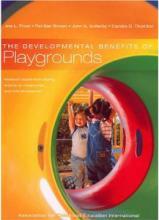
With multiple audiences in mind, The Developmental Benefits of Playgrounds, co-authored by Joe L. Frost, Pei-San Brown, John A. Sutterby, and Candra D. Thornton, reviews selected research by doctoral students and faculty at the University of Texas during a 35 year running research program at Redeemer School in Austin, Texas. This is the third book linked to this program published by the Association for Childhood Education International (ACEI) concerning children's play and playgrounds. These began with When Children Play in 1985, continued with Playground Injuries and Litigation in 1996, and culminated with this volume in 2004.1
The Developmental Benefits of Playgrounds focuses on the importance of playgrounds for children's broad developmental needs. The research reported here refutes common assumptions that outdoor play is primarily for the expenditure of excess energy and for developing gross motor skills. “Analyzed evidence overwhelmingly suggests that the benefits of outdoor play are much more extensive.”2
Among the benefits of unstructured outdoor play as discussed in The Developmental Benefits of Playgrounds are the abilities to make decisions, work and play within a community of others, and to try out ideas and explore the play environment. Also highlighted are the benefits of pretend play, which has recently been shown to further the development of brain synaptic connections. The conclusions by Hirsh-Pasek, Golinkoff, and Perry show that “If children lack opportunities to pretend, their long-term capacities related to critical thinking, problem solving, and social functioning, as well as to academic areas such as literacy, mathematics, and science, may be diminished.”3
Besides the social and academic benefits of play, research indicates that children with play opportunities are not likely to be depressed and hostile and generally do not exhibit excessive fear, rage, and worry.4 These emotional, social, and academic benefits join the physical benefits of strength, coordination, flexibility, and perceptual motor skills which enhance a child's life and help protect him from injury during play.5
Childhood obesity, a topic of national concern, is discussed extensively, noting the trend of overeating, sedentary recreational activities, and school recess and physical education reductions or eliminations. Along with recommendations for reducing obesity, they offer the caution that “children prefer activities that are spontaneous and enjoyable, and emphasis on adult-type physical activity may turn children off to physical activity.”6 They also note a gender difference between activities preferred by boys and girls, which should be incorporated into successful physical activity programs for all children.
Writing to both the playground builders and the playground users, the authors discuss the playground elements of equipment heights, overhead play events, climbing behaviors, swings, and sand and water play. Each element is explored as to the “ways children grow and develop, the ways children play, and the ways that playgrounds can support both of these elements.”7 Included in the discussion is recent and original research, an historical perspective, safety concerns including the expected unintended uses, an overview of equipment types, relevant child development stages, and specific recommendations.
In a concluding chapter, “Playgrounds for the 21st Century,” recommendations for playground designers and builders include such topics as sense of place, sand and water play, organized games, enhanced movement, playground layout and accessibility, proper surfacing, and the variety and complexity of play elements. A Playground Checklist, available in the appendix, lists 60 items to be considered for playgrounds. This tool focuses on what the playground contains, the current condition and safety of the playground, and the desired playground and play leader functions.
This final chapter also includes recommendations for playground users, such as the importance of understanding and minimally guiding child development during their play, the importance of physical activity, and the involvement of children in maintaining the playground. Additionally, the proper role of playground rules – to make play safe, but not overly limit the desire to explore – is emphasized.
In summary, The Developmental Benefits of Playgrounds refutes the “accountability” movement that considers play a waste of time and maintains that “outdoor play is extremely beneficial for all children,” especially through well-designed, well-maintained, and well-supervised playgrounds.8
- 1. Frost, Joe L., Pei-San Brown, John A. Sutterby, and Candra D. Thornton. Introduction. The Developmental Benefits of Playgrounds. Olney, Maryland: Association for Childhood Education International, 2004. p. 9.
- 2. Op.cit., Frost., p. 21.
- 3. Op.cit., Frost., p. 20.
- 4. Op.cit., Frost., p. 21.
- 5. Op.cit., Frost., p. 225.
- 6. Op.cit., Frost., p. 44.
- 7. Op.cit., Frost., p. 213.
- 8. Op.cit., Frost., p. 225.

